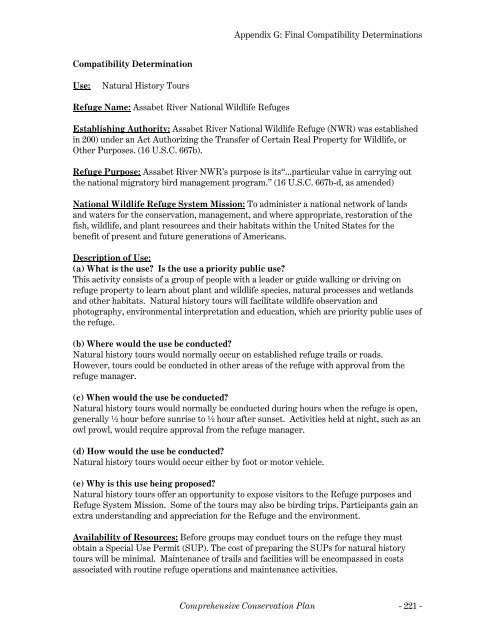Assabet River NWR Final CCP - U.S. Fish and Wildlife Service
Assabet River NWR Final CCP - U.S. Fish and Wildlife Service
Assabet River NWR Final CCP - U.S. Fish and Wildlife Service
You also want an ePaper? Increase the reach of your titles
YUMPU automatically turns print PDFs into web optimized ePapers that Google loves.
Compatibility Determination<br />
Use: Natural History Tours<br />
Refuge Name: <strong>Assabet</strong> <strong>River</strong> National <strong>Wildlife</strong> Refuges<br />
Appendix G: <strong>Final</strong> Compatibility Determinations<br />
Establishing Authority: <strong>Assabet</strong> <strong>River</strong> National <strong>Wildlife</strong> Refuge (<strong>NWR</strong>) was established<br />
in 200) under an Act Authorizing the Transfer of Certain Real Property for <strong>Wildlife</strong>, or<br />
Other Purposes. (16 U.S.C. 667b).<br />
Refuge Purpose: <strong>Assabet</strong> <strong>River</strong> <strong>NWR</strong>’s purpose is its“...particular value in carrying out<br />
the national migratory bird management program.” (16 U.S.C. 667b-d, as amended)<br />
National <strong>Wildlife</strong> Refuge System Mission: To administer a national network of l<strong>and</strong>s<br />
<strong>and</strong> waters for the conservation, management, <strong>and</strong> where appropriate, restoration of the<br />
fish, wildlife, <strong>and</strong> plant resources <strong>and</strong> their habitats within the United States for the<br />
benefit of present <strong>and</strong> future generations of Americans.<br />
Description of Use:<br />
(a) What is the use? Is the use a priority public use?<br />
This activity consists of a group of people with a leader or guide walking or driving on<br />
refuge property to learn about plant <strong>and</strong> wildlife species, natural processes <strong>and</strong> wetl<strong>and</strong>s<br />
<strong>and</strong> other habitats. Natural history tours will facilitate wildlife observation <strong>and</strong><br />
photography, environmental interpretation <strong>and</strong> education, which are priority public uses of<br />
the refuge.<br />
(b) Where would the use be conducted?<br />
Natural history tours would normally occur on established refuge trails or roads.<br />
However, tours could be conducted in other areas of the refuge with approval from the<br />
refuge manager.<br />
(c) When would the use be conducted?<br />
Natural history tours would normally be conducted during hours when the refuge is open,<br />
generally ½ hour before sunrise to ½ hour after sunset. Activities held at night, such as an<br />
owl prowl, would require approval from the refuge manager.<br />
(d) How would the use be conducted?<br />
Natural history tours would occur either by foot or motor vehicle.<br />
(e) Why is this use being proposed?<br />
Natural history tours offer an opportunity to expose visitors to the Refuge purposes <strong>and</strong><br />
Refuge System Mission. Some of the tours may also be birding trips. Participants gain an<br />
extra underst<strong>and</strong>ing <strong>and</strong> appreciation for the Refuge <strong>and</strong> the environment.<br />
Availability of Resources: Before groups may conduct tours on the refuge they must<br />
obtain a Special Use Permit (SUP). The cost of preparing the SUPs for natural history<br />
tours will be minimal. Maintenance of trails <strong>and</strong> facilities will be encompassed in costs<br />
associated with routine refuge operations <strong>and</strong> maintenance activities.<br />
Comprehensive Conservation Plan - 221 -

















